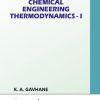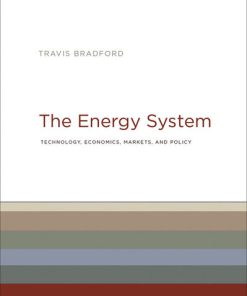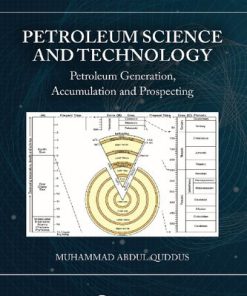Petroleum Refining Technology Economics and Markets 6th Edition by Mark Kaiser, Arno de Klerk, James Gary, Glenn Handwerk ISBN 9781466563025 1466563028
$50.00 Original price was: $50.00.$25.00Current price is: $25.00.
Petroleum Refining Technology Economics and Markets 6th Edition by Mark Kaiser, Arno de Klerk, James Gary, Glenn Handwerk – Ebook PDF Instant Download/Delivery: 9781466563025 ,1466563028
Full download Petroleum Refining Technology Economics and Markets 6th Edition after payment

Product details:
ISBN 10: 1466563028
ISBN 13: 9781466563025
Author: Mark Kaiser, Arno de Klerk, James Gary, Glenn Handwerk
Petroleum Refining Technology Economics and Markets 6th Edition Table of contents:
PART I Markets and Economics
SECTION I Industry Structure and Characteristics
Chapter 1 Performance
1.1 Refinery Supply Chains
1.1.1 Input–Output Model
1.1.2 Infrastructure
1.1.3 Location
1.1.4 Commercial Requirements
1.2 Performance
1.3 Refinery Economics
1.4 Refining Yields
1.5 Refining Margins
1.5.1 Gross Margin
1.5.2 Net Margin and Netback
1.5.3 Application
1.6 Margin Comparisons
1.6.1 Sweet vs. Sour Crude
1.6.2 Cracker vs. Coker Refinery
1.7 Factors That Impact Margins
1.8 Crack Spreads
1.9 Market Data
1.10 Eagle Ford Marker Price
References
Chapter 2 Products
2.1 Overview
2.2 Petroleum Gases
2.2.1 Methane
2.2.2 Ethane
2.2.3 Propane
2.2.4 Butane
2.2.5 Natural Gas Liquids
2.3 Light Distillates
2.3.1 Naphthas
2.3.1.1 Light Naphtha
2.3.1.2 Heavy Naphtha
2.3.2 Gasolines
2.3.2.1 Motor Gasoline
2.3.2.2 Aviation Gasoline
2.4 Middle Distillates
2.4.1 Jet Fuel
2.4.2 Kerosene
2.4.3 Automotive Diesel
2.4.3.1 High-Speed Diesel
2.4.3.2 Light Diesel Oil
2.4.3.3 Gas Oil
2.4.4 Marine Diesel
2.4.5 Light Fuel Oil
2.5 Heavy Fuel Oils
2.6 Specialty Products
2.6.1 Base Oils and Lubricants
2.6.2 Engine Oils
2.6.2.1 Single Grade
2.6.2.2 Multigrade
2.6.3 Greases
2.6.4 Waxes
2.6.5 Bitumen
2.6.6 Petroleum Coke
2.6.7 Carbon Black
References
Chapter 3 Processes
3.1 Overview
3.2 Separation
3.2.1 Perfect Batch Distillation
3.2.2 Distillation Curves
3.2.3 Fractions
3.2.4 Atmospheric Distillation
3.2.5 Vacuum Distillation
3.3 Conversion
3.3.1 Thermal Cracking
3.3.2 Catalytic Cracking
3.3.3 Hydrocracking
3.3.4 Coking
3.4 Finishing
3.4.1 Hydrotreating
3.4.2 Catalytic Reforming
3.4.3 Alkylation
3.4.4 Isomerization
References
Chapter 4 Prices
4.1 Introduction
4.2 Price Formation
4.3 Global Oil and Product Markets
4.4 Price Characteristics
4.4.1 Prices Are Volatile
4.4.2 Prices Are Unpredictable
4.4.3 Business Cycle Impacts Are Periodic
4.4.4 Price Shocks
4.4.5 Market Factors Dominate Price Signals
4.4.6 Private Factors Are Secondary in Price Formation
4.5 Supply and Demand
4.5.1 Supply Curves
4.5.2 Demand Curves
4.5.3 Three Laws of Economics
4.6 Market Factors
4.6.1 Demand
4.6.2 Supply
4.6.3 Production Cost
4.6.4 OPEC
4.6.5 Spare Production Capacity
4.6.6 Supply Disruptions
4.6.7 Technology Impacts
4.7 Private Factors
4.7.1 Quality
4.7.1.1 API Gravity
4.7.1.2 Sulfur Content
4.7.1.3 Naphthenic vs. Paraffinic Crudes
4.7.2 Yield
4.8 World Production circa 2018
4.9 Refined Product Prices
References
Chapter 5 Potpourri
5.1 Business Model
5.1.1 Required Spending
5.1.2 Discretionary Spending
5.1.3 Capital Investments
5.2 Company Classification
5.2.1 Firm Type
5.2.1.1 Integrated
5.2.1.2 Government-Sponsored
5.2.1.3 Independents
5.2.1.4 Joint Ventures
5.2.2 Ownership
5.2.3 Level of Integration
5.2.4 Business Objectives
5.3 U.S. and World Capacity Trends
5.3.1 Distillation
5.3.2 Coking
5.3.3 Catalytic Cracking
5.3.4 Hydrocracking
5.3.5 Hydrotreating
5.3.6 Reforming, Alkylation, and Isomerization
5.3.7 Aromatics and Lubricants
5.3.8 Hydrogen
5.3.9 Sulfur
5.3.10 Asphalt
5.4 U.S. Capacity Correlations
5.5 Market Valuation
5.6 Capital Investment
SECTION II Cost Estimation and Complexity
Chapter 6 Cost Estimation
6.1 Construction Cost Factors
6.1.1 ISBL
6.1.2 USGC Reference
6.1.3 Project Type
6.1.4 Unit Addition vs. Grassroots Refinery
6.1.5 Process Technology
6.1.6 Process Severity
6.1.7 Unit Requirements
6.1.8 Contract Type
6.1.9 Actual vs. Estimated Cost
6.1.10 Time
6.1.11 Location
6.2 Unit Cost
6.2.1 Source Data
6.2.2 Sample Size
6.2.3 Normalization
6.3 Cost Functions
6.3.1 Specification
6.3.2 Dependent Variable
6.3.3 Parameter Estimation
6.3.4 Data Processing
6.3.5 Data Exclusion
6.3.6 Cost Envelopes
6.4 USGC Grassroots Construction Cost
6.5 Operating Cost Factors
6.5.1 Common vs. Unique Factors
6.5.2 Utility Prices
6.5.3 Capacity, Complexity, Age
6.5.4 Time
6.5.5 Location
6.5.6 Exceptional Events
6.6 Operating Expenses
6.6.1 Data Sources
6.6.2 Consolidation Levels
6.7 U.S. Operating Cost Statistics, 2010–2014
References
Chapter 7 Refinery Complexity
7.1 Ideal Refinery
7.2 Nelson Complexity Index
7.2.1 Motivation
7.2.2 Complexity Factor
7.2.3 Refinery Complexity
7.3 Complexity Factors
7.3.1 Definition
7.3.2 Measurement
7.3.3 Complexity Cross Factor
7.3.4 Uncertainty
7.3.5 Traditional Approach
7.3.6 Cost Function Approach
7.4 Refinery Complexity
7.5 U.S. and World Statistics circa 2018
7.5.1 Regional Capacity
7.5.2 U.S. Refining Complexity
7.5.3 Largest World Refineries
7.5.4 Conversion Capacity
7.5.5 FCC-Equivalent Capacity
7.6 Complexity Equation
7.7 Cost Estimation
7.8 Complexity Factor at Reference Capacity
7.8.1 Specification
7.8.2 U.S. CFRC Statistics
References
Chapter 8 Classification
8.1 Refinery Categories
8.2 Very Simple Refinery
8.3 Simple Refinery
8.4 Complex Refinery
8.5 Krotz Springs, Louisiana, Cracking Refinery
8.6 St. Paul Park, Minnesota, Cracking Refinery
Chapter 9 Complexity Applications
9.1 Introduction
9.2 Complexity Functional
9.2.1 Reference Capacity Approach Extension
9.2.2 Complexity Factor Functional Average
9.2.3 Evaluation
9.2.4 Closed-Form Expressions
9.2.5 Comparison
9.2.6 U.S. Refinery Complexity
9.3 Complexity Moments
9.4 Spatial Complexity
9.5 Replacement Cost
9.6 Sales Price Models
9.6.1 Asset Transactions
9.6.2 Formulation
9.6.3 Constraints
9.7 Complexity Barrels
9.8 Inverse Problem
9.8.1 Three-Refinery Example
9.8.2 Matrix Formulation
References
Chapter 10 Three Refineries
10.1 Hydrocracker
10.2 Lubes
10.3 Integrated/Petrochemical
PART II Crude Oil and Refined Products
SECTION III Crude Oil and Properties
Chapter 11 Origin and Composition
11.1 Geologic Time
11.2 Generation, Migration, and Accumulation
11.2.1 Source Rock
11.2.2 Generation
11.2.3 Migration
11.2.4 Accumulation
11.2.5 Sedimentary Basins
11.3 The Hydrocarbon Source
11.3.1 Origin
11.3.2 Kerogen Type
11.3.3 Oil Window
11.3.4 Transformation Sequence
11.3.5 Alteration and Thermal Maturity
11.4 Molecular Composition
11.4.1 Naming Organic Chemicals
11.4.2 Early Classifications
11.4.3 Hydrocarbons
11.4.4 Paraffin (Alkane) Series
11.4.5 Naphthene (Cycloparaffin) Series
11.4.6 Aromatic (Benzene) Series
11.5 Crude Oil Classification
11.5.1 Component Groups
11.5.2 Ternary Diagram
11.5.3 Tissot-Welte Classification
11.5.4 Crude Oil Classes
11.5.4.1 Paraffinic Class
11.5.4.2 Paraffinic–Naphthenic Class
11.5.4.3 Naphthenic Class
11.5.4.4 Aromatic–Intermediate Class
11.5.4.5 Aromatic–Naphthenic and Aromatic–Asphaltic Classes
11.5.5 Marine vs. Nonmarine Organic Matter
11.5.6 High-Sulfur vs. Low-Sulfur Oils
11.6 Alteration and Thermal Maturity Pathways
11.6.1 Thermal Alteration
11.6.2 Deasphalting
11.6.3 Biodegradation
11.6.4 Water Washing
References
Chapter 12 Crude Quality
12.1 Indicators
12.1.1 Color
12.1.2 Density
12.1.3 Heteroatoms
12.1.4 Chemical Structure
12.1.5 Viscosity
12.2 Classification
12.3 Blends of Crude Oils
12.3.1 Additive Properties
12.3.2 Nonadditive Properties
References
Chapter 13 Distillation Profile
13.1 Distillation Curves
13.2 Laboratory Methods
13.2.1 Standards
13.2.2 ASTM D86
13.2.3 ASTM D1160
13.2.4 ASTM D2892
13.2.5 ASTM D2887
13.2.6 ASTM D6352, D7169
13.3 Hempel Method
13.3.1 Procedure
13.3.2 Pressure Correction
13.3.3 Temperatures beyond 790°F
13.3.4 Midpercent Curves
13.3.5 Heavy Hydrocarbons
13.4 Distillation Profile Construction
13.5 Hasting Field, Texas
13.6 North Slope Crude, Alaska
References
Chapter 14 Crude Properties
14.1 Bayou Choctaw and West Hackberry Blends
14.2 Crude Oil Assay
14.3 Chemical Properties
14.3.1 Elemental Analysis
14.3.2 PNA Composition
14.3.3 Carbon Residue
14.4 Composition
14.4.1 Carbon–Hydrogen Ratio
14.4.2 Sulfur
14.4.3 Nitrogen
14.4.4 Metals
14.4.5 Asphaltenes
14.4.6 Resins
14.4.7 Waxes
14.4.8 Salt Content
14.4.9 Acid Number
14.5 Physical Properties
14.5.1 API Gravity
14.5.2 UOP Characterization Factor
14.5.3 Viscosity
14.5.4 Pour Point
14.5.5 Reid Vapor Pressure
References
Chapter 15 Fraction Characterization
15.1 Correlation Relations
15.2 Carbon Hydrogen Weight Ratio
15.3 Carbon Residue
15.4 Asphaltene Content
15.5 Molecular Weight
15.6 Aniline Point
15.7 Smoke Point
15.8 Viscosity
15.9 Refractive Index
15.10 Cloud Point
15.11 Pour Point
15.12 Freezing Point
15.13 Cetane Index
15.14 Molecular Type Composition
References
SECTION IV Fuel Specifications
Chapter 16 Standards, Specifications, and Fuel Quality
16.1 Types of Specifications
16.2 Consensus Specifications Definitions
16.3 Test Methods
16.4 Transportation Fuel Specifications
16.4.1 Gasoline – ASTM D4814
16.4.2 Jet Fuel – ASTM D1655
16.4.3 Diesel – ASTM D975
16.4.4 European Automotive Fuels
16.5 Mandatory and Suggested Specifications
16.6 Enforcement
16.7 Fuel Quality
16.8 Properties Not in Specifications
References
Chapter 17 Gasoline
17.1 Introduction
17.2 Octane Number
17.3 Volatility
17.3.1 Vapor Pressure
17.3.2 Distillation Profile
17.3.3 Vapor–Liquid Ratio
17.3.4 Vapor Lock Index
17.3.5 Drivability Index
17.3.6 Volatility Specifications and Schedules
17.4 Composition
17.5 Corrosion
17.6 Storage and Stability
17.7 Energy Content
17.7.1 Heating Value
17.7.2 Power
17.7.3 Fuel Economy
17.8 Additives and Blending Components
17.9 Fuel Ethanol for Blending
17.9.1 Purity
17.9.2 Water, Methanol, Chloride Content
17.9.3 Acidity
17.9.4 Sulfur Content
17.9.5 Denaturants
17.9.6 Workmanship
17.10 Aviation Gasoline
References
Chapter 18 Jet Fuels
18.1 Introduction
18.2 Specifications
18.3 Fluidity
18.4 Volatility
18.5 Stability
18.6 Heat Content
18.7 Combustion Characteristics
18.8 Composition
18.9 Lubricity
18.10 Corrosion
18.11 Contaminants
18.12 Additives
References
Chapter 19 Diesel Fuel
19.1 Introduction
19.2 Specifications
19.3 Cetane Number
19.4 Distillation
19.5 Flash Point
19.6 Lubricity
19.7 Ash Content
19.8 Carbon Residue
19.9 Low Temperature Operability
19.10 Stability
19.11 Blendstocks
19.12 Biodiesel
19.13 Other Middle Distillate Products
References
Chapter 20 Product Blending
20.1 Introduction
20.2 Gasoline Blendstocks
20.3 Reid Vapor Pressure
20.3.1 Theoretical Method
20.3.2 Blending Indices
20.4 Octane Blending
20.5 Blending for Other Properties
20.6 Gasoline Blending Case Study
20.7 Ethanol Blending
20.8 Diesel and Jet Fuel Blendstocks
References
PART III Technology
SECTION V Separation Processes
Chapter 21 Crude Oil Desalting
21.1 Introduction
21.2 Desalting Technology
21.2.1 General Description
21.2.2 Tight Emulsions and Metal Containing Organic Compounds
References
Chapter 22 Crude Oil Distillation
22.1 Introduction
22.2 Atmospheric Distillation
22.2.1 General Description
22.2.2 Front-End Design Configurations
22.2.3 Light Naphtha Stabilizer Column
22.3 Vacuum Distillation
References
Chapter 23 Solvent Deasphalting
23.1 Introduction
23.2 Solvent Deasphalting Technology
23.2.1 General Description
23.2.2 Bitumen Froth Treatment
23.3 Deasphalting
23.3.1 Oil Solubility
23.3.2 Asphaltenes
References
SECTION VI Residue Conversion Processes
Chapter 24 Visbreaking
24.1 Introduction
24.2 Visbreaking Technology
24.2.1 Feed Material
24.2.2 General Description
24.2.3 Hydrovisbreaking and Hydrogen Donor Visbreaking
24.2.3.1 Hydrovisbreaking
24.2.3.2 Hydrogen Donor Visbreaking
24.3 Thermal Cracking
24.3.1 Reaction Chemistry
24.3.2 Conversion
24.3.3 Equivalent Residence Time
24.4 Visbreaker Operation
24.4.1 Operating Parameters
24.4.1.1 Temperature and Residence Time
24.4.1.2 Pressure
24.4.2 Fuel Properties
24.4.2.1 Asphaltenes
24.4.3 Feed Pretreatment
References
Chapter 25 Coking
25.1 Introduction
25.2 Coking Technology
25.2.1 Feed Material
25.2.2 Delayed Coking Technology
25.2.2.1 Coke Removal from Delayed Coking
25.2.3 Fluid Coking Technology
25.2.3.1 Flexicoker Fuel Gas
25.3 Thermal Carbonization
25.3.1 Reaction Chemistry and Phase Separation
25.3.2 Role of Solids
25.4 Delayed Coker Operation
25.4.1 Operating Parameters
25.4.1.1 Furnace Coil Outlet Temperature
25.4.1.2 Pressure
25.4.1.3 Recycle Ratio
25.4.1.4 Coker Cycle Time
25.4.2 Coke Properties
25.4.3 Fuel Properties
25.4.4 Yield Estimation
25.5 Fluid Coker Operation
25.5.1 Operating Parameters
25.5.1.1 Temperature
25.5.1.2 Pressure
25.5.2 Fuel Properties
25.5.3 Yield Estimates
References
Chapter 26 Residue Hydroconversion
26.1 Introduction
26.2 Residue Hydroconversion Technology
26.2.1 Feed Material
26.2.2 Reactor Types
26.2.3 Fixed Bed Residue Hydroconversion Technology
26.2.4 Moving Bed Residue Hydroconversion Technology
26.2.5 Ebullated Bed Residue Hydroconversion Technology
26.2.6 Slurry Bed Residue Hydroconversion Technology
26.3 Thermal Conversion Combined with Catalytic Hydrotreating
26.3.1 Reaction Chemistry
26.3.2 Sediment Formation
26.3.3 Residue Hydroconversion Catalysts
26.4 Residue Hydroconversion Operation
26.4.1 Operating Parameters
26.4.1.1 Operating Temperature
26.4.1.2 Operating Pressure and H2 Partial Pressure
26.4.1.3 Fresh H2 and H2-to-Oil Feed Rate
26.4.1.4 Space Velocity
26.4.1.5 Catalyst Replacement Rate
26.4.2 Product Yields
References
Chapter 27 Fluid Catalytic Cracking
27.1 Introduction
27.2 Fluid Catalytic Cracking Technology
27.2.1 Feed Material
27.2.2 General Description
27.2.3 Residue Fluid Catalytic Cracking
27.2.4 FCC for Petrochemicals Production
27.3 Catalytic Cracking
27.3.1 Reaction Chemistry
27.3.2 Conversion
27.3.3 FCC Catalysts
27.3.4 Catalyst Deactivation and Equilibrium Catalyst
27.3.5 Catalyst Additives
27.4 Fluid Catalytic Cracking Operation
27.4.1 Operating Parameters
27.4.1.1 Fresh Feed to Recycled Feed Ratio
27.4.1.2 Preheat Temperature
27.4.1.3 FCC Riser Outlet Temperature
27.4.1.4 Pressure
27.4.1.5 Catalyst Activity and Selectivity
27.4.1.6 Catalyst-to-Oil Ratio and Catalyst Circulation Rate
27.4.1.7 Regenerator Temperature and Hot Catalyst Temperature
27.4.1.8 Combustion Airflow Rate
27.4.2 Pressure Balance
27.4.3 Heat Balance
27.4.4 Fuel Properties
27.4.4.1 Naphtha for Motor Gasoline
27.4.4.2 Light Cycle Oil for Jet Fuel or Diesel Fuel
27.4.5 Feed Pretreating
27.4.6 Yield Estimation
References
Chapter 28 Hydrocracking
28.1 Introduction
28.2 Hydrocracking Technology
28.2.1 Feed Material
28.2.2 General Description
28.2.3 Hydroisomerization to Produce Lubricant Base Oil
28.2.4 Hydrodewaxing
28.4.5 Mild Hydrocracking
28.3 Catalytic Hydrocracking
28.3.1 Reaction Chemistry
28.3.2 Conversion
28.3.3 Hydrocracking Catalysts
28.3.3.1 Acid Sites and Acid Support Materials
28.3.3.2 Metal Sites and Metal Site Activation
28.3.3.3 Metal-to-Acid Site Activity Ratio
28.3.4 Competitive Adsorption
28.4 Hydrocracker Operation
28.4.1 Operating Parameters
28.4.1.1 Temperature
28.4.1.2 Total Pressure and H2 Partial Pressure
28.4.1.3 Hydrogen-to-Feed Ratio
28.4.1.4 Liquid Hourly Space Velocity
28.4.2 Fuel Properties
28.4.2.1 Naphtha for Motor Gasoline
28.4.2.2 Kerosene for Jet Fuel
28.4.2.3 Gas Oil for Diesel Fuel
28.4.3 Yield Estimates
References
SECTION VII Distillate, Naphtha, and Gas Conversion Processes
Chapter 29 Hydrotreating
29.1 Introduction
29.2 Hydrotreating Technology
29.2.1 Feed Material
29.2.2 General Description
29.3 Catalytic Hydrotreating
29.3.1 Reaction Chemistry
29.3.1.1 Olefin and Diolefin Saturation
29.3.1.2 Hydrodearomatization
29.3.1.3 Hydrodesulfurization
29.3.1.4 Hydrodenitrogenation
29.3.1.5 Hydrodeoxygenation
29.3.1.6 Hydrodemetallization
29.3.2 Reaction Thermodynamics
29.3.3 Conversion
29.3.4 Hydrotreating Catalysts
29.3.4.1 Sulfided Base Metal Catalysts
29.3.4.2 Reduced Noble Metal Catalysts
29.4 Hydrotreater Operation
References
Chapter 30 Butane and Naphtha Hydroisomerization
30.1 Introduction
30.2 C4–C6 Hydroisomerization Technology
30.2.1 Feed Material
30.2.2 General Description
30.2.3 Process Configurations with Recycle
30.3 Catalytic Hydroisomerization
30.3.1 Reaction Chemistry
30.3.2 Reaction Thermodynamics
30.3.2.1 C4 Hydroisomerization
30.3.2.2 C5 Hydroisomerization
30.3.2.3 C6 Hydroisomerization
30.3.3 Hydroisomerization Catalysts
30.4 C4–C6 Hydroisomerization Operation
30.4.1 Operating Parameters
30.4.2 Fuel Properties
References
Chapter 31 Catalytic Naphtha Reforming
31.1 Introduction
31.2 Naphtha Reforming Technology
31.2.1 Feed Material
31.2.2 General Description
31.2.3 Catalyst Regeneration Configurations
31.2.3.1 Continuous Catalyst Regeneration
31.2.3.2 Semiregenerative
31.2.3.3 Cyclic Regeneration
31.2.4 Catalyst Regeneration
31.2.5 Aromatization for Petrochemical Production
31.3 Catalytic Naphtha Reforming
31.3.1 Reaction Chemistry
31.3.2 Conventional Reforming Catalysts
31.4 Catalytic Naphtha Reforming Operation
31.4.1 Operating Conditions
31.4.2 Fuel Properties
31.4.3 Yield Estimation
References
Chapter 32 Aliphatic Alkylation
32.1 Introduction
32.2 Aliphatic Alkylation Technology
32.2.1 Feed Material
32.2.2 HF-Catalyzed Aliphatic Alkylation
32.2.2.1 HF Alkylation Plant Safety
32.2.3 H2SO4-Catalyzed Aliphatic Alkylation
32.2.3.1 Autorefrigeration Process
32.2.3.2 Effluent Refrigeration Process (Stratco Process)
32.2.3.3 Packed Column Process
32.2.4 Comparison of HF- and H2SO4-Catalyzed Processes
32.3 Reaction Chemistry
32.3.1 Liquid Acid Catalysts
32.3.2 Solid Acid Catalysts
32.4 Aliphatic Alkylation Operation
32.4.1 Operating Parameters
32.4.1.1 Temperature
32.4.1.2 Acid Strength
32.4.1.3 Isobutane-to-Olefin Ratio
32.4.1.4 Residence Time
32.4.2 Fuel Properties
References
Chapter 33 Olefin Oligomerization
33.1 Introduction
33.2 Olefin Oligomerization Technology
33.2.1 Feed Material
33.2.2 Fixed Bed Olefin Oligomerization
33.2.3 Liquid Phase Olefin Oligomerization
33.2.4 Catalyst Selection
33.2.5 Refinery Benzene Reduction
33.3 Reaction Chemistry
33.3.1 Acid Catalysts
33.3.2 Organometallic Catalysts
33.4 Oligomerization Operation
33.4.1 Operating Parameters
33.4.1.1 Temperature
33.4.1.2 Pressure
33.4.1.3 Space Velocity
33.4.2 Fuel Properties
33.4.2.1 Naphtha for Motor Gasoline
33.4.2.2 Kerosene for Jet Fuel
33.4.2.3 Distillate for Diesel Fuel
References
Chapter 34 Etherification
34.1 Introduction
34.2 Etherification Technology
34.2.1 Feed Material
34.2.2 General Description
34.3 Etherification
34.3.1 Reaction Chemistry
34.3.2 Reaction Thermodynamics
34.3.3 Etherification Catalysts
34.4 Etherification Operation
34.4.1 Operating Parameters
34.4.2 Volumetric Yield
34.4.3 Fuel Properties of Alcohols and Ethers
References
SECTION VIII Lubricants and Supporting Technologies
Chapter 35 Lubricant Base Oils
35.1 Introduction
35.2 Lubricant Base Oil Production Technology
35.2.1 Feed Material
35.2.2 Technology Selection
35.2.3 Propane Deasphalting
35.2.4 Solvent Extraction
35.2.4.1 Furfural Extraction
35.2.4.2 Phenol Extraction
35.2.4.3 NMP Extraction Process
35.2.5 Solvent Dewaxing
35.2.5.1 Ketone Dewaxing
35.2.5.2 Propane Dewaxing
35.2.6 Clay Treating
References
Chapter 36 Supporting Technologies
36.1 Hydrogen Production and Purification
36.2 Light Hydrocarbon Gas Processing
36.3 Acid Gas Removal
36.4 Sulfur Recovery from Acid Gas
36.4.1 Claus Process
36.4.2 Claus Tail Gas Treatment
References
Appendix A: Glossary
Appendix B: Discussion Questions
Appendix C: Problems
Index
People also search for Petroleum Refining Technology Economics and Markets 6th Edition:
petroleum refining technology economics and markets sixth edition pdf
petroleum refining technology economics and markets pdf
petroleum refining technology and economics fifth edition
petroleum refining technology and economics crc press
Tags:
Mark Kaiser,Arno de Klerk,James Gary,Glenn Handwerk,Petroleum Refining Technology
You may also like…
Education Studies & Teaching - Studying & Test Preparation
Technique - Fuel Technology
Computers - Internet & World Wide Web
Business & Economics - Economics
Uncategorized
Computers - Algorithms and Data Structures
Multimedia Security Algorithm Development Analysis and Applications Kaiser J. Giri











